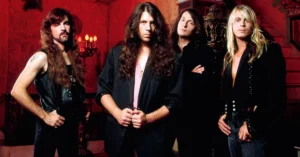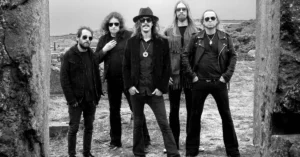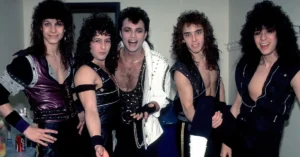Dream Theater: Architects of Modern Progressive Metal
Dream Theater. Origins at Berklee: The Birth of a New Sound
Dream Theater was formed in 1985 by three students from Berklee College of Music in Boston: John Petrucci (guitar), John Myung (bass), and Mike Portnoy (drums). Originally named Majesty, the group’s name was changed after another band claimed rights to it. Keyboardist Kevin Moore and vocalist Chris Collins joined early on, though Collins was soon replaced.

From their inception, Dream Theater was defined by technical precision, ambitious compositions, and a blend of progressive rock complexity with heavy metal aggression—a combination that would later define the genre known as progressive metal.
Dream Theater. Key Lineups Over Time
- John Petrucci – guitars, backing vocals (1985–present)
- John Myung – bass (1985–present)
- Mike Portnoy – drums, backing vocals (1985–2010, 2023–present)
- Kevin Moore – keyboards (1985–1994)
- James LaBrie – vocals (1991–present)
- Jordan Rudess – keyboards (1999–present)
- Mike Mangini – drums (2010–2023)
This core quintet (Petrucci, Myung, LaBrie, Rudess, and Portnoy) is often regarded as the band’s most iconic formation.

Dream Theater. The Albums That Shaped a Genre
1. When Dream and Day Unite (1989)
Dream Theater’s debut featured vocalist Charlie Dominici and laid the groundwork for their technical approach, though it received limited attention at the time.
2. Images and Words (1992)
- The breakthrough album
- Featured James LaBrie on vocals
- Included the MTV and radio hit “Pull Me Under”
This album fused prog and metal with accessibility, earning gold certification and global recognition.
3. Awake (1994)
Darker and heavier than its predecessor, with standout tracks like:
- “Lie”
- “The Mirror”
- “Scarred”
This would be Kevin Moore’s last album with the band.
4. Falling Into Infinity (1997)
A more commercial-leaning record under label pressure, causing internal tension but still offering complex gems like “Lines in the Sand” and “Trial of Tears.”
5. Metropolis Pt. 2: Scenes from a Memory (1999)
A full-concept album and one of Dream Theater’s crowning achievements. It follows a hypnotic regression therapy story with stunning musicianship throughout.
Fan favorites include:
- “Home”
- “The Dance of Eternity”
- “Finally Free”
6. Six Degrees of Inner Turbulence (2002)
A double album exploring mental illness, spiritual crisis, and human endurance. The 42-minute title suite stands as one of their most ambitious undertakings.
7. Train of Thought (2003)
Heavier and more metal-oriented, with songs like “As I Am” and “Endless Sacrifice,” appealing to fans of thrash and groove metal.
8. Octavarium (2005)
A return to classic prog influences, especially in the epic 24-minute title track, which echoes Pink Floyd, Genesis, and Rush.
9. Systematic Chaos (2007) and 10. Black Clouds & Silver Linings (2009)
These albums mixed narrative grandeur with crushing riffs and lengthy compositions like “The Count of Tuscany” and “In the Presence of Enemies.”
11. A Dramatic Turn of Events (2011)
First album after Mike Portnoy’s departure. Drummer Mike Mangini joined the band, though Petrucci programmed drums on this record. Key track:
- “Breaking All Illusions”
12. Dream Theater (2013)
A self-titled effort that balanced compact and epic songs like:
- “The Enemy Inside” (Grammy-nominated)
- “Illumination Theory”
13. The Astonishing (2016)
A rock opera divided into two acts and 34 tracks, telling a dystopian tale with cinematic orchestration. Ambitious but divisive among fans.
14. Distance Over Time (2019)
A return to tighter songwriting and a heavier, riff-driven style. Highlights include:
- “Barstool Warrior”
- “Pale Blue Dot”
15. A View from the Top of the World (2021)
Includes the 20-minute title track and continued Dream Theater’s tradition of high-caliber progressive metal craftsmanship.
Dream Theater. Musical Style and Characteristics
Dream Theater blends:
- Complex time signatures
- Shifting key modulations
- Virtuosic solos and instrumental passages
- Conceptual storytelling
- Dramatic dynamics
Influences range from Yes, Rush, and Genesis to Metallica, Iron Maiden, and Mahavishnu Orchestra. Each member contributes a distinct layer:
- Petrucci with blistering yet melodic solos
- Myung with intricate bass runs
- Rudess on keys blending classical, synth, and jazz fusion
- Portnoy/Mangini with precise, explosive drumming
- LaBrie adding theatrical vocal flair
Dream Theater. Notable Side Projects
- Liquid Tension Experiment (Petrucci, Portnoy, Rudess, Tony Levin)
- Transatlantic (Portnoy with members of Spock’s Beard, Marillion, and The Flower Kings)
- Sons of Apollo, Flying Colors, and solo work by each member further demonstrate their versatility.
Grammy Recognition and Return of Portnoy (2023)
In 2022, Dream Theater won their first Grammy Award for “The Alien”, from A View from the Top of the World.
In October 2023, they announced the return of founding drummer Mike Portnoy, reuniting the classic core trio of Petrucci, Myung, and Portnoy for the first time in 13 years.
Legacy and Influence
Dream Theater’s impact is immense in both progressive and metal circles. They helped define progressive metal and opened the door for bands like:
- Symphony X
- Haken
- Periphery
- Opeth (in their progressive era)
- Between the Buried and Me
- Tool (as stylistic cousins)
With over 15 million albums sold worldwide, they remain one of the few progressive bands to achieve sustained global success while staying musically uncompromising.
Interesting Facts
- John Myung is known for his near-silent off-stage presence, often called the “quiet force” of the band.
- Petrucci and Portnoy are childhood friends and co-founders of Liquid Tension Experiment.
- The band has maintained an unwavering focus on live precision, frequently performing entire albums or marathon-length shows.
- Their fan community is one of the most dedicated and analytical, dissecting musical themes and lyrical motifs across albums.
- Metropolis Pt. 2 is often ranked among the greatest concept albums of all time.







